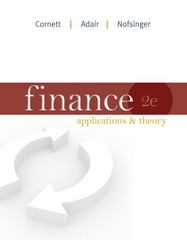Question
1. Suppose that S = $1.1045/ and F=$1.1459/ (one year). The annualized risk-free interest rates are 2.6% and 1.75% in the U.S and Germany, respectively.
1. Suppose that S = $1.1045/ and F=$1.1459/ (one year). The annualized risk-free interest rates are 2.6% and 1.75% in the U.S and Germany, respectively. If feasible, find the profit earned by a U.S. investor conducting a covered interest arbitrage. Suppose that the U.S. investor is able to borrow $500,000. Do not write any symbol. Make sure to round your answers to the nearest 100th decimal points. For example, write 234.45 for $234.45.
2. Suppose that S = $1.1045/. The annualized inflation rates are 2.6% and 1.75% in the U.S and Germany, respectively. Find the exact expected currency movement for the euro in 5 years. Do not write any symbol. Express your answers as a percentage. Make sure to round your answers to the nearest 100th decimal points. For example, write 2.45 for 2.45%.
3. Suppose that S = 180/$. The annualized risk-free rates are 4.6% and 2.75% in Japan and the U.S., respectively. Find the expected currency movement over the next 3 years. Do not write any symbol. Express your answers as a percentage. Make sure to round your answers to the nearest 100th decimal points.
4. Suppose that S = 180/$. The annualized risk-free rates are 4.6% and 2.75% in Japan and the U.S., respectively. The annualized inflation rate is 2% in Japan. Find the exact real interest rate in Japan and the U.S. according to the international Fisher relation. Do not write any symbol. Express your answers as a percentage. Make sure to round your answers to the nearest 100th decimal points.
Step by Step Solution
There are 3 Steps involved in it
Step: 1

Get Instant Access to Expert-Tailored Solutions
See step-by-step solutions with expert insights and AI powered tools for academic success
Step: 2

Step: 3

Ace Your Homework with AI
Get the answers you need in no time with our AI-driven, step-by-step assistance
Get Started


